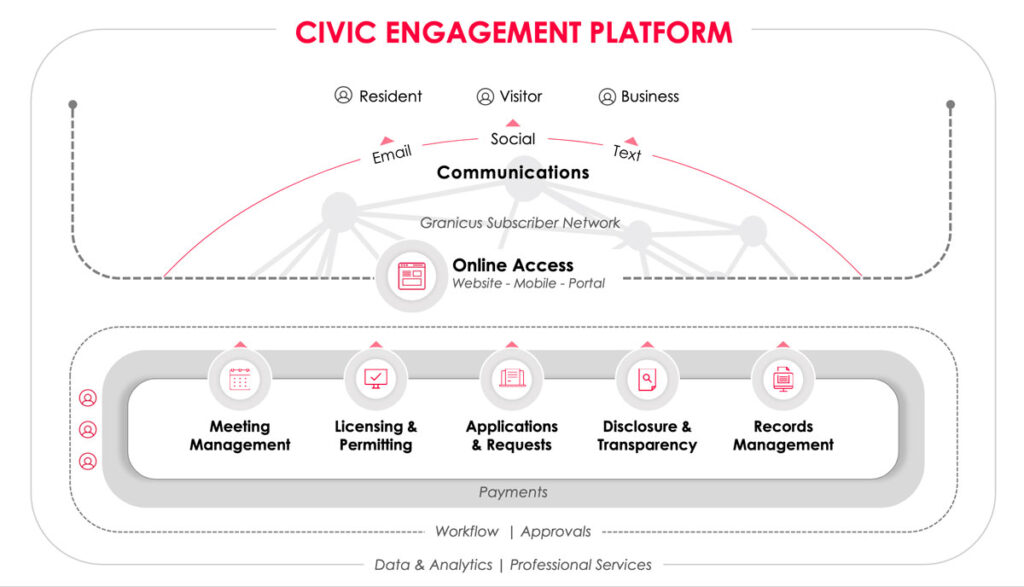Building Your Platform – A Bite-Sized Approach to Digital Transformation
This year has brought a number of new challenges for government agencies and, along with those challenges, a host of new buzzwords. Terms like “digital transformation,” “remote collaboration,” and “digital platforms” are hot topics in 2020 and can represent daunting objectives – but this doesn’t need to be the case.
A digital platform is just a term for how various pieces of your online presence – including your website, service delivery processes, public meeting systems, communication tools, and backend data services – function together to deliver a superior experience for both your community and employees.
For most government organizations, it would be impractical to overhaul all these elements at the same time, which is why I advocate for a modular, “bite-sized” approach to digital transformation. Let’s take a deeper look at the concept to understand how.
What is a digital platform?
While each government will have its own unique systems, processes, and technology, for many agencies, a digital platform can be divided into four key components:
- The Website – Your online presence where customers will find your information, services, and other media.
- Outbound Communications – Whether it be e-mail, SMS, or social media, these are the tools and technologies you use to proactively communicate with residents.
- Database, Services, and Workflows – For tasks such as renewing licenses, requesting information, or reporting problems, this is where your residents come to get things done. This also includes the workflows employees use to process requests.
- Public Meetings and Records – The legislative processes and materials associated with publicly-available meetings, agendas, and minutes.
Too Much to Handle
Together, these various elements combine to create a compelling customer journey for your residents as they view your website, access resources, and interact with your employees. For governments, the connections between the component parts give you powerful new ways to leverage data, automate activities, and engage your residents.
For example, for those clerks who are accustomed to fielding inbound requests for agenda and minutes items, they could also use an outbound email tool to automatically push that information out to interested residents.
Nevertheless, when you look at the above graphic and begin to envision the possibilities, it’s easy to get overwhelmed. Tight budgets, pandemic concerns, and rising customer expectations have created a pressure cooker of challenges for each and every city, county, and state agency throughout the country – yet there’s still a way to address short-term concerns while still making headway on your longer-term objectives.
The Bite-sized Approach
A bite-sized, modular approach allows you to make gradual and sustainable changes over time that both address your immediate needs while building towards a long-term objective.
> Identify your immediate problem
Take time to list your top digital challenges. Are website visitors getting lost while trying to find the agenda and minutes of a recent Planning Committee meeting? Are internal employees having trouble keeping track of FOIA requests or board applications? Be clear in describing your problem – whether it be internal or external.
> Prescribe your solutions
After you’ve identified your most pressing problem(s), take a close look at the root cause. For example, if website visitors are having trouble finding Planning Committee minutes, could that issue be solved by having a more user-friendly website or by pushing that information out through email? There are a variety of tactics to mitigate any problem, but you’ll want to be sure you’re promoting the right results.
> Sketch out your digital roadmap
Once you’ve listed your problems and potential solutions, place these various elements in a timeline. What problems do you need to solve right away? What solutions are “nice-to-have” but not immediately necessary? As much as possible, this process should be interactive and collaborative as you solicit responses and input from various team members. As you consider technology to help solve for your most pressing issues, choosing partners that have the tools that can build and scale for advancing needs should be top of mind as you prepare for the future.
> Be ready to adapt
As this year has illustrated, every plan needs a backup plan. Be prepared to shift the segments of your long-term modernization plans to meet the immediate needs of the day. By choosing a flexible solution that can scale and adapt over time, you’ll empower your agency and ensure you don’t need to change vendors every time a new problem emerges. Some of the most innovative government solutions have come in response to immediate crises, and there’s no reason you can’t adopt creative approaches to solve long-standing problems.
One Step at a Time
The process laid out above provides a general format for how you can strategically identify problem areas, prescribe solutions, and schedule improvements in a way that makes sense for your customers and your employees. While large-scale, agency-wide projects may seem ambitious, don’t let the distance to your final destination prevent you from taking that first step.

